Everyday Language II
Naming, Scanning, and Planning with Colors, Numbers, and Shapes

Games on this CD.
Everyday Language II contains 8 games that expand on the concepts introduced in Vol. I. In addition to counting from 0 to 20, naming 9 basic colors, and discriminating size, the student will learn basic geometric shapes, and complex two and three dimensional shapes.
Target Audience Appropriate for 1st-3rd grade for teaching the math concepts of sets and the vocabulary of geometric shapes to neurotypical toddlers, kindergarteners, as well as children with Autism, PDD, Down Syndrome, Cerebral Palsy, comprehension problems, weak visual memory skills.
Everyday Language II
by LocuTour Multimedia
Windows Only
Information for Professionals
The new vocabulary is presented in a movie format with the examples of concepts demonstrated as if the teacher were right there providing examples on the whiteboard.
The CD provides the opportunity to develop receptive/expressive language, rapid automatic naming, visual scanning, visual perceptual discrimination, figure ground discrimination, auditory discrimination, auditory memory, verbal rehearsal strategies, reasoning, and planning skills. The cognitive skills of planning, rotation in space and visualizing shapes are an important component of the Dominoes and Plug Ins games.
The language of math is as important to learn as the language of the playground or the language of the kitchen. In order for a child to use these concepts in the classroom, they must have made the connection between the words, the symbols and the concepts that they represent. As an example, the number three is a word, a shape and a representation of the concept, “threeness”. An underlying language problem will make it difficult for the child to understand math in the classroom as well as hinder their application of math to everyday activities.
The objectives of this CD are to teach 28 two and three dimensional shapes, 9 colors, counting sets, and the concepts of scanning the visual field, pre-planning and spatial rotation.
These games were designed for students at the pre-school to second grade levels. The format is intentionally low key and simple in order to provide an uncomplicated background for learning these concepts. The multisensory approach requires the student to listen to directions, make choices, drag and drop objects, and repeat information aloud. A record function allows students to practice new vocabulary and compare their pronunciation to the game’s recordings.
Games on this CD.
Shaping Up
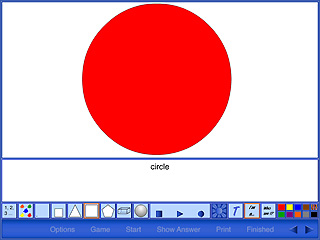
In Shaping Up the student learns to identify 21 numbers, 9 colors, 12 shape components, 6 classes of shapes, 5 classes of triangles, 5 simple shapes, 5 complex shapes, 6 three-dimensional concepts, and 8 three-dimensional shapes.
There are three levels of play: the Training level; the I’m a... level; and the Who Am I? level. In the first, the computer presents concepts and shapes with a definition, description, and examples. In the second level the computer displays a picture, names it, and moves to the next picture. In the final level the computer displays a picture and asks, “Who am I?”. The computer answers the question after a pause. The teacher selects the length of the pause.
Sorter
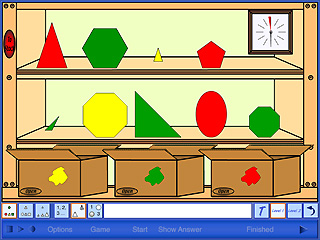
Sorter helps students develop efficient visual scanning skills when they search for a target and place the target into the correctly labeled box. The second level of play encourages rapid identification of salient features. The student picks up the targets as they move rapidly along a conveyor belt and places them in the correct box.
Again, there are three levels of play: the Training level; the Stock Room level; and the Factory Conveyor Belt level. Students in the Training level match numbers and shapes by color, type, or size. Students in the Stock Room match numbers and shapes in a timed task. The third level, the conveyor belt, is a timed exercise that includes foils. In other words, shapes not belonging to any box may come along the conveyor belt and the student must ignore them.
Plug Ins
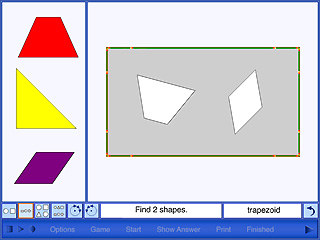
Plug Ins teaches children how to rotate shapes in space and correctly match the shape to the target spot. This is an excellent game for developing mental imagery of shapes.
In order to get the shapes to fit, the student uses the cognitive strategies of pre-planning, scanning, and visualization of shape rotation on a two dimensional plane.
1,2,3... How Many Do You See?
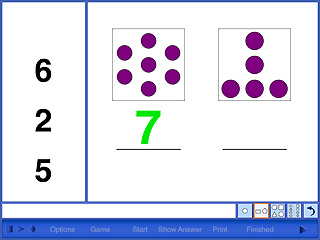
In 1,2,3... How Many Do You See? the students learn the concept of “set” while they count and label the number of objects in each set.
Students make associations between quantities in sets and written numerals utilizing efficient attention, scanning and number recognition skills.
Match Ups!
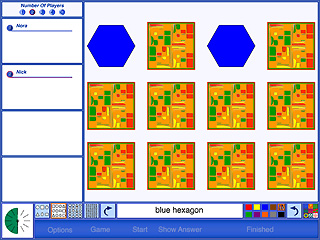
Match Ups! tests visual memory skills for numbers, shapes, and colors. This game has four difficulty levels and several options to make each game a challenge.
Students encode object or numeric information into working memory and demonstrate accurate retrieval of information in a concentration-like game. They learn to use auditory and visual planning strategies for efficient retrieval.
Shapes Around Us
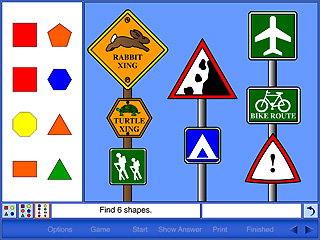
In Shapes Around Us children learn to distinguish the target objects hidden in a scene. The scenes become more complex as the levels increase.
Students begin to learn how to scan for information efficiently and how to distinguish relevant from irrelevant information.
Bingo!
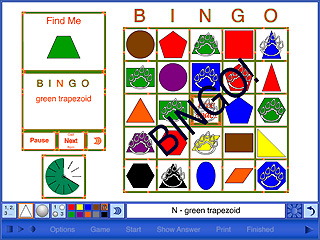
Everyone loves to play Bingo! Listen carefully for your target and see if you can get five in a row.
Students get more practice isolating the relevant feature of the target and matching like features.
While playing Bingo! they process auditory and/or visual information for location, color, shape or number.
Dominoes
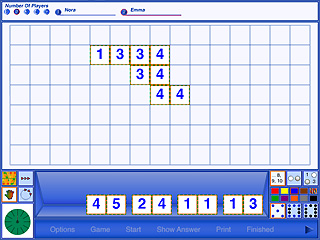
Play with a friend, or play Dominoes with the computer. Match the tiles to the tiles already placed on the game board. Be the first to use up all your tiles and you win! The tile choices are numerals, shapes, or a combination of numerals and shapes.
Dominoes is an excellent divided and shifting attention task because of the sequence of actions required to rotate and match the tiles.
